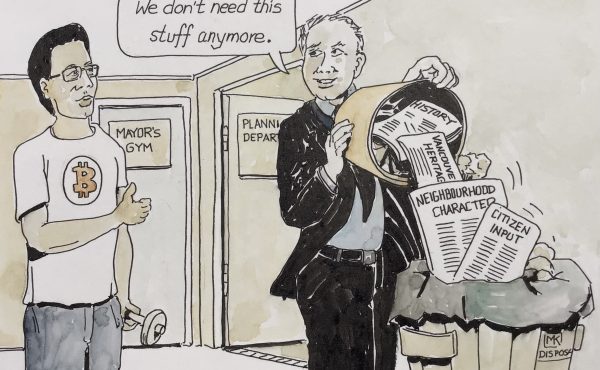
The same day Beyond Vague Terrain: The City and the Serial Image closed at the Surrey Art Gallery, Artswest had an exhibition in the new Surrey Library.
Artswest is an amateur artists’ group. If you think of grandmas with paint boxes you’ll get a sense of the type of art here. I’m sure you could find something to match the couch.
The new Surrey Library is part of the development of a city core for B.C.’s second-largest city. Anchored at one end with the Central City tower, straddling the Surrey Central Skytrain station, and reaching north to encompass a recreation centre, the new library, a new city hall (now just a hole in the ground), a spectacular hotel/convention/living tower in the offing, and there is even more potential the further north you go.
The Surrey Art Gallery, in contrast, is 12 blocks due south along the King George Highway, a major north/south artery. That’s a mile-and-a-half. Here’s a bit of trivia: there are eight Surrey blocks in a mile, 12 in a Vancouver (or city) mile. If you’re not driving you’ll need to catch the number 325 bus, grab a cab or walk along the highway.
And somehow this geography and coincidence of exhibitions seems to sum up both the concepts that inform the pieces in Vague Terrain, and the peculiar nature of a public art gallery in this not-quite-urban setting.
There have been a few reviews about the exhibit already: Gordon Price did “Beyond Vague Terrain: Finding Vancouver in Surrey“, and the new blogazine Surrey604 did “Serial Images and Reading the City“. The official release is here.
Vague Terrain is the third in a series of exhibitions curated by Jordan Strom that are about the relationship of the city and suburbs. Previously there was “Checking in with your hotspots”, 2009, which was about art around highways and “Sitely premises”, 2011, covering domestic activity in the exterior spaces of homes.
The works here tug away at the notion of centre and periphery, at the idea of multiple centres, and at the ‘in-between’ city —something that’s not quite landscape, not quite city. They poke at the periphery, and at what Strom calls the ‘defeatured landscape’, where a generic space can stand in for any city. It’s a tension between the abstract and the unique.
If that doesn’t describe the stereotype of Surrey, I don’t know what does.
The pieces cover a range of time from the 1970s to the present, and are mainly about Vancouver places, although there are a few specific to Surrey.
Only a few were the sorts of things anyone could hang on the wall behind the piano. And that leads to the peculiar purpose of these sorts of works in a public place. The problem with any of these works is that to be able to appreciate them you need years of education and immersion in the practices that they come from. If you’re missing that, you need the patience to wade through dense jargon-laden didactic statements and the tenacity to try to piece together the metadata you’ll need for comprehension.
Compare and contrast this with the Artswest exhibit where, in the ostensible centre of Surrey, the new Surrey, the casual browser can flit through easy-to-digest visual works and either quickly dismiss them as irrelevant or appreciate something without having to think too hard, or rethink what they think they’re thinking.
That’s not to say the pieces in Vague Terrain don’t have value. There’s a visceral interest in trying to find the Scotia tower in a room full of photos of it; and an eye-brow-raising appreciation of the mind-numbing effort of photographing all the bus stops in Surrey. The projects from the 1970s are interesting as documentation of that time period. The bus stop piece is already dated but will become interesting again in a decade or two when we can look at those photos and say “wow, they had trees back then.”
But journalistic documentation is not the primary intent of the exhibition. The real purpose is to jar the public (or at least the art gallery-going public) into seeing that ‘defeatured landscape’ with fresh eyes.
I wonder if the primary value of this sort of exhibit would be for city planners or developers or those types of people: people who haven’t had the benefit of an arts background that teaches deconstruction as a matter of course.
***
Born and raised in Surrey, Don Schuetze has returned to the land of his youth after about a quarter of a century elsewhere. But do you ever really leave? Don works for a media company in Vancouver as a production hack, schlepping together print and online products. Reach him through his half-done site http://www.southofthefraser.com which is all about, wait for it… Surrey.




